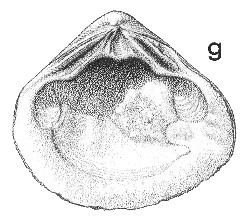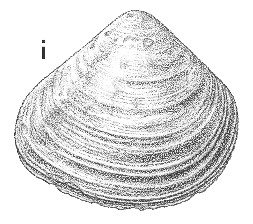
Revised descriptions of New Zealand Cenozoic Mollusca from Beu and Maxwell (1990)

 | Revised descriptions of New Zealand Cenozoic Mollusca from Beu and Maxwell (1990) | 
|
  (Pl. 39g): GS12857, V20/f136, Kaiwaka South Road, southwest of Devil's Elbow, 30 km north of Napier, central Hawke's Bay, Nukumaruan (GNS) |
  (Pl. 39i): GS12857, V20/f136, Kaiwaka South Road, southwest of Devil's Elbow, 30 km north of Napier, central Hawke's Bay, Nukumaruan (GNS) |
Beu & Maxwell (1990): Chapter 15; p. 312; pl. 39 g,i.
Synonymy: Hemimactra crassa Hutton 1885b, p. 322; Mactra (Mactroderma) crassa of Suter 1915, p. 57 (secondary homonym of Mactra crassa Turton, 1822); Mactra crassitesta Finlay 1927b, p. 531 (new name for Mactra crassa (Hutton), preoccupied); Spisula (Spisulona) crassitesta, Beu & Maxwell 1990, 312, pl. 39g, i; Spisula crassitesta, Beu 2004, p. 166
Type species of Spisulona Marwick, 1948; synonymised with Spisula Gary, 1837 by Beu (2004, p. 166).
Classification: Mactridae: Mactrinae
Description: Moderate-sized for genus (43-57 mm long), subtrigonal, very thick and solid, moderately inflated, almost equilateral, with short, straight anterodorsal margin, slightly longer, straight, postero-dorsal margin, and strongly convex ventral margin. Exterior smooth except for prominent growth ridges and weak ridge extending from umbo to postero-ventral corner. Hinge very thick, with 2 long, very thick, coarsely transversely striated lateral teeth on each side in right valve and 1 on each side in left valve, and beneath umbo deep, narrow, spoon-shaped resilifer and (presumably) very small, thin cardinal teeth (broken off all known material). Adductor scars oval, almost identical, deeply impressed. Pallial sinus very small, rounded, at anterior end of posterior adductor scar.
Comparison: The very thick shell, solid hinge with coarsely ridged lateral teeth, and evenly trigonal shape make Spisula crassitesta easily recognised, and are very similar characters to those of the type species of Spisula, S. solida (Linnaeus, 1758), Recent, NE Atlantic. The Waipipian S. couttsi (Otahuhu Brewery well) is longer, less evenly triangular, and with a much thinner shell. Slightly thinner, more oval, but less equilateral specimens from the late Nukumaruan Maxwell Group at Ototoka Beach, Wanganui were interpreted by Beu (2004) as part of the variation of S. crassitesta. The species group of Crassula aequilatera (Tongaporutuan-Recent; abundant now on oceanic sand beaches) is readily distinguished by its much more strongly trigonal form, with a prominent, sharp umbonal-ventral ridge at the posterior end, and by its smooth lateral teeth. Crassula aequilatera is the youngest species of a New Zealand genus related to Australian taxa such as Austromactra Iredale, 1930, rather than being related to Spisula.
Distribution: Nukumaruan; "Wanganui", type; the precise locality has never been discussed or resolved, but the most probable horizons are Nukumaru Limestone or Tewkesbury Formation at Nukumaru Beach. A restricted but uncommon Nukumaruan species, occurring in high-energy, shallow-water (e.g., coquina limestone) or estuarine deposits in Wanganui basin and Hawke's Bay; two valves were collected with many specimens of Barytellina, Pseudocardium, Limnoperna and Zeacumantus and a few valves of Cyclomactra in the estuarine bed on Kaiwaka South Road, central Hawke's Bay.
Cite this publication as: "A.G. Beu and J.I. Raine (2009). Revised
descriptions of New Zealand Cenozoic Mollusca from Beu and Maxwell (1990). GNS
Science miscellaneous series no. 27."
© GNS Science, 2009
ISBN
978-0-478-19705-1
ISSN 1177-2441
(Included with a PDF facsimile file
copy of New Zealand Geological Survey Paleontological Bulletin 58 in CD version
from: Publications Officer, GNS Science, P.O. Box 30368 Lower Hutt, New
Zealand)